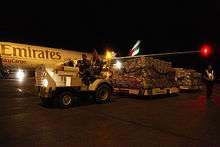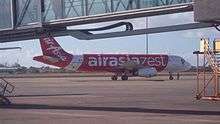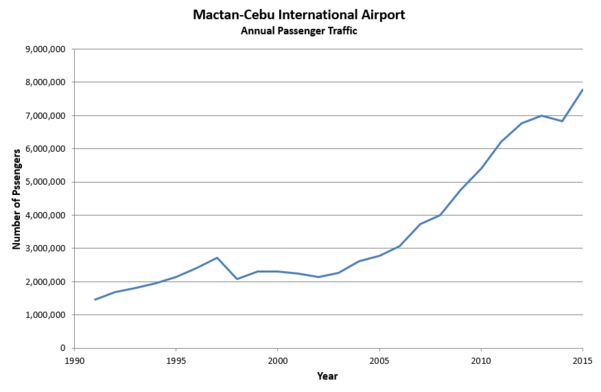Mactan–Cebu International Airport
| Mactan–Cebu International Airport Tugpahanang Pangkalibutan sa Mactan–Sugbo (Cebuano) Paliparang Pandaigdig ng Mactan–Cebu (Filipino) | |||||||||||
|---|---|---|---|---|---|---|---|---|---|---|---|
 | |||||||||||
|
Exterior of Mactan–Cebu International Airport | |||||||||||
| IATA: CEB – ICAO: RPVM | |||||||||||
| Summary | |||||||||||
| Airport type | Public | ||||||||||
| Operator | Mactan–Cebu International Airport Authority | ||||||||||
| Serves | Metro Cebu and Central Visayas | ||||||||||
| Location | Lapu-Lapu Airport Road, Barangay Ibo, Lapu-Lapu City, Metro Cebu, Central Visayas | ||||||||||
| Hub for |
Cebu Pacific PAL Express Philippine Airlines Philippines AirAsia | ||||||||||
| Built | 1956 | ||||||||||
| Elevation AMSL | 11 m / 36 ft | ||||||||||
| Coordinates | 10°18′48″N 123°58′58″E / 10.31333°N 123.98278°ECoordinates: 10°18′48″N 123°58′58″E / 10.31333°N 123.98278°E | ||||||||||
| Website | mactancebuairport.com | ||||||||||
| Map | |||||||||||
.svg.png) CEB/RPVM Location in the Philippines | |||||||||||
| Runways | |||||||||||
| |||||||||||
| Statistics (2015) | |||||||||||
| |||||||||||
|
2015 MCIAA Statistcs | |||||||||||
Mactan–Cebu International Airport (Cebuano: Tugpahanang Pangkalibutan sa Mactan–Sugbo, Filipino: Paliparang Pandaigdig ng Mactan–Cebu) (IATA: CEB, ICAO: RPVM) located in Central Visayas region, is the second busiest airport of the Philippines.[1] It is located in Lapu-Lapu City on Mactan Island, part of Metro Cebu. The airport is managed by the Mactan–Cebu International Airport Authority. It covers an area of 797 hectares (1,970 acres).
It has a single 3,300-meter (10,800 ft) runway that was built by the United States in 1956 as an emergency airport for Strategic Air Command bombers and was known as the Mactan Air Base.[2] The runway is complemented by a full-length taxiway that it shares with the current Mactan Air Base of the Philippine Air Force.
Mactan–Cebu International Airport was chosen as the most viable location for the world's largest aircraft, the Antonov An-225 Mriya, to safely land when considering the combination of onward land transportation, sea freight, and airport capacity. The arrival of the aircraft in the airport marked the very first time that the aircraft landed in the Philippines.[3]
History
The runway was built by the United States Air Force in 1956 as an emergency airport for Strategic Air Command bombers and it was known as the Mactan Air Base.[2] It remained a spartan outpost until the Vietnam War in the 1960s when it became a base for a C-130 unit of the U.S. Air Force.[2]
In the mid-1960s, the civilian airport was opened, to replace the Lahug Airport (now the site of Cebu IT Park), which could no longer be expanded due to safety and physical problems. The airport was later expanded to the current Mactan–Cebu International Airport (MCIA).
On August 20, 2008, the Mactan–Cebu International Airport Authority (MCIAA) announced that about 300 million Philippine pesos will be spent for the terminal expansion program to address the increasing volume of passenger traffic. MCIAA former general manager Danilo Augusto Francia said the program also includes the establishment of a second passenger terminal in the Mactan–Cebu International Airport.[4] In 2009, former general manager Francia announced for the public bidding for the construction of the new generation terminal to service only international flight.
In 2010, the newly elected Philippine President, Benigno Aquino III selected Nigel Paul Villarete as the new General Manager of the Mactan–Cebu International Airport (MCIA)[5] and Chief Executive Officer (CEO) of MCIAA. Mr. Villarete prioritized the completion of the terminal expansion[6] and the completion of the unfinished administration building.[7]


Following Typhoon Haiyan (Yolanda), one of the biggest typhoons ever recorded and one of the most destructive typhoons in the Philippines, the airport was used as a center for air operations for the relief effort. The airport is centrally located in the Visayas which was the region most affected by the storm, especially the Eastern Visayas islands of Leyte and Samar. The Cebu airport was relatively unaffected by the storm while the airports of the Eastern Visayas were unusable immediately after.
On November 12, 2013, the world's longest and heaviest aircraft, the Antonov An-225 Mriya, landed at MCIA from the Zagreb International Airport in Croatia for the first time in the Philippines to deliver a 180-ton replacement transformer from the Croatian energy company KONČAR to the First Gen Corporation's power plant in Batangas City. Officials of First Gen approached MCIAA General Manager Nigel Paul Villarete to allow the Antonov An-225 to utilize the airport for the transportation of their delivery after officials from Clark International Airport, the Ninoy Aquino International Airport in Manila, and Subic Bay International Airport refused to allow the aircraft to utilize their airports.[8] According to First Gen President Francis Giles Puno, MCIA had been inspected by Antonov Airlines, the owner of the Antonov An-225 aircraft, as the most viable option for their aircraft, "after considering the combination of airport, onward land transport and sea freight."[9]
On April 23, 2014, the Department of Transportation and Communications awarded the operations and maintenance of MCIA to a consortium of the Philippine Megawide Construction Corporation and Bangalore-based GMR Infrastructure. The consortium won with a bid of 17.5 billion Philippine pesos. MCIAA will turn over to the private consortium the operations and maintenance of the airport starting October 2014.[10] The new terminal building to be designed by Integrated Design Associates Ltd. (IDA)[11] is expected to be completed by 2018.[12]
Airlines and destinations
The existing terminal houses both domestic and international operations and has an annual capacity of 4.5 million passengers.[13]
- Notes
- ^1 : This flight make a stop in Clark on the way back from Cebu to Dubai. However, the airline does not have traffic rights to transport passengers solely between Cebu and Clark (only from Dubai to Cebu or to Clark AND from Cebu or Clark to Dubai).
- ^2 : This flight makes an intermediate stop between Cebu and the listed destination. However, it has no rights to transport passengers solely between Cebu and the intermediate stop.
| Destinations maps |
|---|
Destinations around the world |
Operational statistics[22][23]

| Year | Passenger
movements |
% Change from
Previous Year |
|---|---|---|
| 1991 | 1,459,669 | |
| 1992 | 1,690,015 | |
| 1993 | 1,808,745 | |
| 1994 | 1,958,706 | |
| 1995 | 2,149,107 | |
| 1996 | 2,402,384 | |
| 1997 | 2,718,621 | |
| 1998 | 2,071,804 | |
| 1999 | 2,296,154 | |
| 2000 | 2,302,849 | |
| 2001 | 2,252,733 | |
| 2002 | 2,135,216 | |
| 2003 | 2,272,782 | |
| 2004 | 2,611,762 | |
| 2005 | 2,778,664 | |
| 2006 | 3,070,612 | |
| 2007 | 3,731,500 | |
| 2008 | 3,991,250 | |
| 2009 | 4,762,903 | |
| 2010 | 5,413,452 | |
| 2011 | 6,215,946 | |
| 2012 | 6,771,318 | |
| 2013 | 6,996,112 | |
| 2014 | 6,839,849 | |
| 2015 | 7,781,239 |
Accidents and incidents
On December 11, 1994, Philippine Airlines Flight 434 was flying on its second leg of the Ninoy Aquino International Airport – Mactan–Cebu International Airport – New Tokyo International Airport (now Narita International Airport) route when a bomb on board exploded, killing a passenger. The airliner was able to make an emergency landing. Authorities later found out that Ramzi Yousef planted the bomb on the airliner to test the bomb for his Project Bojinka plot. His project was discovered in Manila after an apartment fire on the night of January 5 and the morning of January 6, 1995.
Ramzi Yousef was on board Flight 434 from Manila when he planted the bomb beneath a vacant seat. He used a fake identity thus he was able to pass through security in Manila. Yousef set the time for the bomb to blow off when the airplane was already in its Cebu–Tokyo leg. Yousef got off the plane during the stopover in Cebu from Manila.
References
- ↑ Hoontrakul, P. (2014). The Global Rise of Asian Transformation: Trends and Developments in Economic Growth Dynamics. New York: Palgrave Macmillan.
- 1 2 3 "Mactan–Benito Ebuen Air Base". Globalsecurity.org. Retrieved July 22, 2013.
- ↑ "POWERNEWS | POWERnEWS | Page 235". cherjam.wordpress.com. Retrieved 2016-02-19.
- ↑ Mactan–Cebu airport to set aside P300-M for expansion
- ↑ Positive News Media, "P-Noy names four Cebuanos to Mactan airport board", http://www.allvoices.com/s/event-6803478/aHR0cDovL3Bvc2l0aXZlbmV3c21lZGlhLm5ldC9hbTIvcHVibGlzaC9CdXNpbmVzc18xOS9QLU5veV9uYW1lc19mb3VyX0NlYnVhbm9zX3RvX01hY3Rhbl9haXJwb3J0X2JvYXJkLnNodG1s
- ↑ http://www.passengerterminaltoday.com, news, "Expanded Mactan–Cebu to open in November," http://www.passengerterminaltoday.com/news.php?NewsID=27172
- ↑ Gregg M. Rubio/FPL (The Freeman), November 3, 2010, "Villarete to finish MCIAA administrative building despite corruption tag," http://www.philstar.com/Article.aspx?articleId=626707&publicationSubCategoryId=107
- ↑ Alegado, Sieg (November 12, 2013). "World's biggest plane to deliver 140-ton power generator to PHL". GMA News Online. GMA Network Inc. Retrieved December 21, 2015.
- ↑ Sollane, Jose (November 13, 2013). "World's biggest airplane in Cebu". The Freeman. PhilStar Daily, Inc. Retrieved December 21, 2015.
- ↑ http://www.philstar.com/business/2014/04/23/1314907/megawide-gmr-remits-p16.1-b-payment-cebu-airport-project
- ↑ http://www.mb.com.ph/megawide-gmr-airport-design-reflects-cebu-culture/
- ↑ http://asia.nikkei.com/Business/Business-Briefs/PhilippineIndia-consortium-to-overhaul-Cebu-airport-by-2018
- ↑ http://ppp.gov.ph/?p=7469
- 1 2 3 "CEB launches 3 more routes to boost the Visayas region" (Press release). Cebu Pacific. 2016-07-05. Retrieved 2016-07-05.
- ↑ http://www.routesonline.com/news/38/airlineroute/269551/philippine-airlines-schedules-cebu-singapore-flights-from-dec-2016/
- ↑ http://www.routesonline.com/news/38/airlineroute/270143/philippine-airlines-expands-caticlan-routes-from-dec-2016/
- ↑ "AirAsia W16 Cebu – Kuala Lumpur service changes". routesonline. Retrieved 5 October 2016.
- ↑ http://thestandard.com.ph/business/219415/ph-air-asia-adds-singapore-flight.html
- ↑ http://www.routesonline.com/news/38/airlineroute/269236/philippines-airasia-adds-taiwan-service-from-nov-2016/
- ↑ "T'Way Air adds Daegu – Cebu service from Dec 2016". routesonline. Retrieved 31 October 2016.
- ↑ https://twitter.com/Airlineroute/status/775569899829747712
- ↑ "PASSENGER MOVEMENT". www.mciaa.gov.ph. Retrieved 2016-10-31.
- ↑ "Mactan-Cebu International Airport Passengers 2015" (PDF).
External links
| Wikimedia Commons has media related to Mactan-Cebu International Airport. |
- Mactan-Cebu International Airport
- Mactan–Cebu International Airport Authority
- Mactan Cebu International Airport - Flight Status and Updates for Travelers to and from cebu
- Airport information for RPVM at World Aero Data. Data current as of October 2006.Source: DAFIF.
- Current weather for RPVM at NOAA/NWS
- Airport information for CEB / RPVM at Great Circle Mapper. Source: DAFIF (effective October 2006).
- Accident history for CEB / RPVM at Aviation Safety Network
_-_Mactan_International_(Gen_Benito_Ebuen_AB)_(CEB_-_RPVM)_AN2256521.jpg)
.svg.png)

